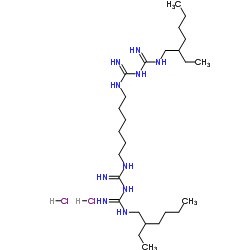Alexidine and chlorhexidine bind to lipopolysaccharide and lipoteichoic acid and prevent cell activation by antibiotics.
Mateja Zorko, Roman Jerala
Index: J. Antimicrob. Chemother. 62(4) , 730-7, (2008)
Full Text: HTML
Abstract
Many antibiotics used to treat infections cause release of immunostimulatory cell wall components from bacteria. Therefore, a combination of antimicrobial and endotoxin-neutralizing activity is desired to prevent inflammation induced by destroyed bacteria. Chlorhexidine and alexidine are amphipathic bisbiguanides and could neutralize bacterial membrane components as stimulators of Toll-like receptors (TLRs).Binding of chlorhexidine and alexidine to lipopolysaccharide (LPS) and lipoteichoic acid (LTA) was determined by fluorescence displacement assay and isothermal calorimetric titration. Neutralization of the biological effect of LPS and LTA on TLR-activated cellular activation was determined by NF-kappaB reporter luciferase activation on cells transfected with specific TLRs and NO production of murine macrophages in the presence of isolated agonists and antibiotic-treated bacteria.Alexidine and chlorhexidine bind not only to LPS but also to LTA from Gram-positive bacteria. Alexidine has a higher affinity than chlorhexidine for both compounds. Calorimetric titration shows an initial endothermic contribution indicating participation of hydrophobic interactions in LPS binding, while binding to LTA displayed initial exothermic contribution. Both compounds prevent cell activation of TLR4 and TLR2 by LPS and LTA, respectively. The addition of both compounds suppressed NO production by macrophages in the presence of bacteria treated with different types of antibiotics.Chlorhexidine and alexidine suppress bacterial membrane-induced cell activation at concentrations two orders of magnitude lower than that used in topical applications. Combining biocides with different types of antibiotics prevented macrophage activation in the presence of bacteria and demonstrated the potential of chlorhexidine and alexidine to suppress inflammatory responses caused by activation of TLRs.
Related Compounds
| Structure | Name/CAS No. | Molecular Formula | Articles |
|---|---|---|---|
 |
Alexidine dihydrochloride
CAS:1715-30-6 |
C26H58Cl2N10 |
|
Chemical interaction of alexidine and sodium hypochlorite.
2012-01-01 [J. Endod. 38(1) , 112-6, (2012)] |
|
Quantitative high throughput screening using a primary human...
2015-01-01 [Nat. Commun. 6 , 6220, (2015)] |
|
Pan-antimicrobial failure of alexidine as a contact lens dis...
2012-07-01 [Eye Contact Lens 38(4) , 222-6, (2012)] |
|
Amoebicidal activities of alexidine against 3 pathogenic str...
2009-01-01 [Eye Contact Lens 35(1) , 1-5, (2009)] |
|
Mechanism of drug failure in fusarium keratitis, 2004-2006.
2014-01-02 [N. Engl. J. Med. 370(1) , 88-9, (2014)] |